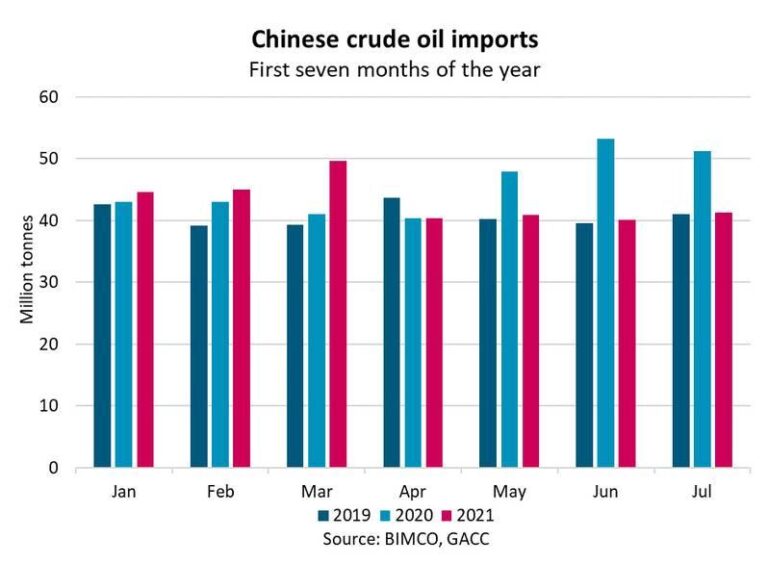China’s crude oil imports in September saw a year-on-year increase of 3.9%, according to Reuters, despite a 4.5% decline from the previous month. The figures reflect shifting dynamics in the world’s second-largest oil consumer as it navigates fluctuating domestic demand and global market conditions. This latest data offers insight into China’s energy consumption trends amid ongoing economic adjustments and geopolitical factors impacting supply chains.
China’s September Oil Imports Show Yearly Growth Amid Monthly Decline
China’s crude oil imports in September have demonstrated a noticeable year-on-year increase of 3.9%, reflecting the continued resilience of the world’s largest oil consumer amid global market fluctuations. However, the monthly figures reveal a contraction, with a 4.5% drop compared to August’s import volumes. This decline may be attributed to seasonal maintenance at refineries and adjustments in domestic demand patterns as the country navigates ongoing economic challenges and energy policy shifts.
- Total imports in September: Approximately 10.5 million barrels per day (bpd)
- Monthly decrease: 4.5% from August’s 11 million bpd
- Yearly growth: 3.9% above September 2023 levels
| Month | Import Volume (Million BPD) | Monthly Change (%) |
|---|---|---|
| July 2024 | 10.8 | +1.2% |
| August 2024 | 11.0 | +2.7% |
| September 2024 | 10.5 | -4.5% |
Impact of Seasonal Demand and Global Market Trends on China’s Crude Oil Intake
China’s crude oil intake in September reflects a nuanced interplay between seasonal fluctuations and shifting dynamics in the global energy market. After a summer of high demand supporting industrial output and transportation needs, the easing into autumn traditionally marks a slowdown in oil imports. This seasonal deceleration was evident as intake dropped 4.5% from August levels, underscoring the predictable cyclical nature of China’s energy consumption. At the same time, the year-on-year increase of 3.9% illustrates a broader resilience fueled by strategic stockpiling and sustained economic recovery efforts amid lingering uncertainties in global supply chains.
The evolving global market trends further complicate import patterns, with China’s crude oil demand reacting to price volatility, trade negotiations, and geopolitical tensions. Key influencing factors include:
- OPEC+ production decisions: Adjustments in output have a direct impact on China’s cost and sourcing strategies.
- US shale oil production: Rising volumes influence global prices and supply availability.
- Shifts in refinery margins: Domestic refining economics guide the timing and volume of crude runs.
- Import diversification: China’s increasing focus on Middle Eastern and Russian crude affects intake levels.
| Factor | Effect on Crude Intake |
|---|---|
| Seasonal Demand | Temporary decrease post-summer peak |
| Global Price Fluctuations | Influences timing and volume of imports |
| Geopolitical Risks | Encourages stockpiling and strategic purchasing |
| Trade Policies | Shape sourcing and supply chain decisions |
Strategic Recommendations for Energy Stakeholders to Navigate Volatile Import Patterns
In the face of fluctuating import volumes like China’s recent 3.9% year-on-year rise but 4.5% month-on-month drop, energy stakeholders must adopt a dynamic approach to supply chain management. This includes diversifying sourcing portfolios beyond reliance on a limited number of exporters and enhancing real-time market intelligence capabilities. Prioritizing flexible contract terms can also mitigate risks associated with sudden shifts in cargo volumes or pricing, ensuring smoother adjustments during periods of volatility.
Furthermore, investing in strategic storage infrastructure will provide a buffer against unexpected shortfalls or surpluses. Stakeholders should also strengthen collaboration with governments and industry bodies to align policies supporting energy security and sustainable market development. Below is an illustrative framework of critical focus areas for immediate action:
| Focus Area | Strategic Action | Expected Outcome |
|---|---|---|
| Diversification | Expand supplier base across regions | Reduced supply risk |
| Market Intelligence | Implement real-time tracking tools | Faster response to market changes |
| Contract Flexibility | Negotiate adaptable terms | Improved negotiation power |
| Storage Capabilities | Increase reserves & emergency stocks | Enhanced supply security |
Wrapping Up
In summary, China’s oil imports in September exhibited a mixed trajectory, rising 3.9% compared to the same month last year while declining 4.5% from August levels. This fluctuation reflects ongoing shifts in demand and supply dynamics amid a complex global energy landscape. As China continues to navigate economic recovery and energy strategies, market watchers will closely monitor future import trends for further insight into the world’s largest crude importer’s outlook.




